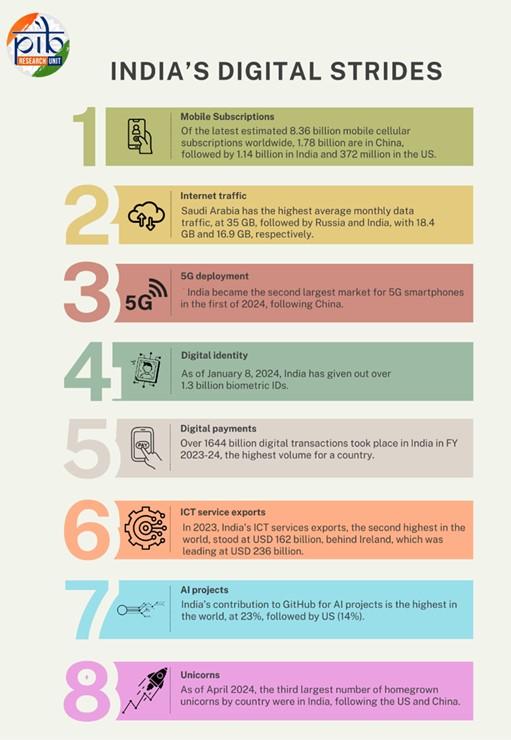India’s digital economy is a key driver of both economic growth and employment, with an increasing role in empowering women in the workforce and creating new opportunities across various sectors.
By Santosh Kumar and Sarla Meena
India’s digital economy is expected to grow almost twice as fast as the overall economy, contributing to nearly one-fifth of national income by 2029-30, according to the State of India’s Digital Economy Report 2024. This, say the report’s authors, means that in less than six-years, the share of digital economy will become larger than that of country’s agriculture or the manufacturing sectors.
The report says that India is the third largest digitalised country in the world in terms of economy-wide digitalization, and twelfth among the G20 countries in the level of digitalisation of individual users.
In the short run, the highest growth is likely to come from the growth of digital intermediaries and platforms, the report says. This will be followed by higher digital diffusion and digitalisation of the rest of the economy and will eventually lower the share of digitally enabling ICT industries in the digital economy.
India’s digital economy has emerged as a significant contributor to its economic growth, accounting for 11.74 per cent of the GDP (INR 31.64 lakh crore or USD 402 billion) in 2022-23. Employing 14.67 million workers (2.55 per cent of the workforce), the digital economy is nearly five times more productive than the rest of the economy.
The report says that digitally enabling industries such as ICT services and manufacturing of electronic components, computers, and communication equipment, which form the core, contributed 7.83 per cent of GVA (Gross Value Added), while digital platforms and intermediaries added another 2 per cent of GVA. Furthermore, digitalisation in traditional sectors like Banking, Financial Services, and Insurance (BFSI), retail, and education added 2 per cent of GVA, showcasing the pervasive impact of digital transformation.
Digitalisation of Traditional Sectors
Projections made by the report writers indicate the digital economy’s share will grow to 20 per cent of GVA by 2029-30, outpacing agriculture and manufacturing. Key growth drivers include the rapid adoption of AI, cloud services, and the rise of global capability centres (GCCs), with India hosting 55 per cent of the world’s GCCs. GCCs are offshore centres established by multinational corporations to provide a variety of services to their parent organisations, including research and development, IT support, and business process management.
The primary survey and stakeholder discussions highlighted interesting facts about how different sectors are digitalising and their contribution to the revenue generated by firms. Not all aspects of businesses are digitalising uniformly. For example, retail sales are digitalising much more than wholesale sales. Firms are also investing in digital methods for customer acquisition and business development. Chatbots and AI applications are fairly commonplace, the report says. Further the report says:
- In the BFSI sector, over 95 per cent of banking payment transactions are digital, but revenue-generating activities like loans and investments remain largely offline, with financial services less digitalised overall.
- Retail is shifting to omni-channel models, with e-tailers adding physical stores, while AI chatbots and digital inventory tools enhance efficiency.
- Education has begun adopting offline, online, and hybrid models, with most institutions favouring hybrid approaches
- Hospitality and logistics are embracing AI, metaverse, and digital tools, with large firms fully digitalising operations, while smaller players lag behind.

Way Forward
By 2030, India’s digital economy is projected to contribute nearly one-fifth of the country’s overall economy, outpacing the growth of traditional sectors. Over the past decade, digital-enabling industries have grown at 17.3 per cent, significantly higher than the 11.8 per cent growth rate of the economy as a whole. Digital platforms, in particular, have expanded rapidly, with an anticipated growth rate of approximately 30 per cent in the coming years.
In 2022-23, the digital economy accounted for 14.67 million workers, or 2.55 per cent of India’s workforce, with the majority of these jobs (58.07 per cent) in the digital-enabling industry. Though the workforce is predominantly male, digital platforms have contributed to increasing job opportunities for women, especially in sectors where mobility and safety concerns were previously barriers.
India’s digital economy is a key driver of both economic growth and employment, with an increasing role in empowering women in the workforce and creating new opportunities across various sectors. The rapid expansion of digital platforms signals an ongoing transformation that is set to shape the future of work in India.

